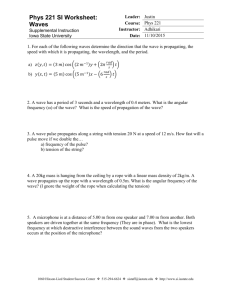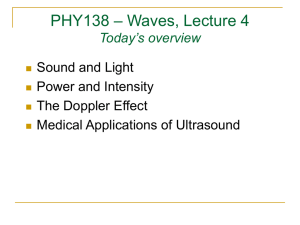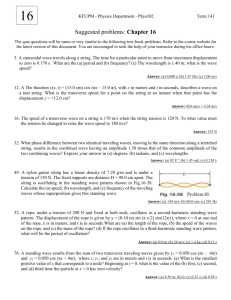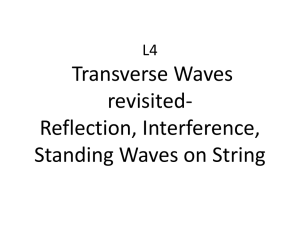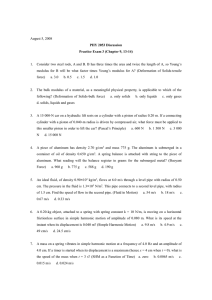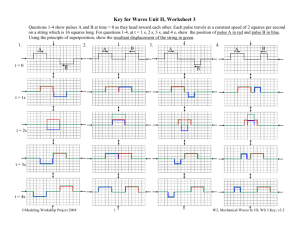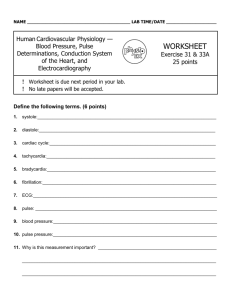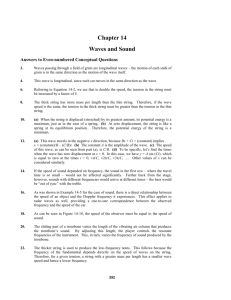Wave Motion and Sound
advertisement
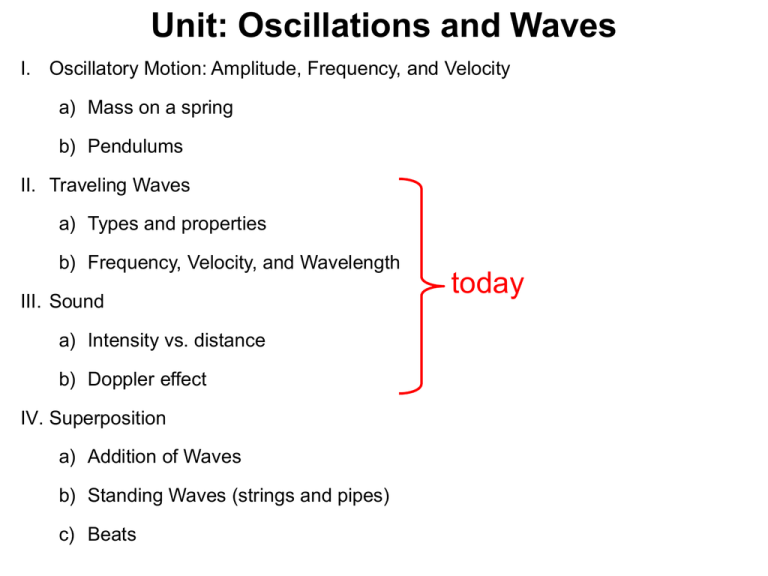
Unit: Oscillations and Waves I. Oscillatory Motion: Amplitude, Frequency, and Velocity a) Mass on a spring b) Pendulums II. Traveling Waves a) Types and properties b) Frequency, Velocity, and Wavelength III. Sound a) Intensity vs. distance b) Doppler effect IV. Superposition a) Addition of Waves b) Standing Waves (strings and pipes) c) Beats today y Wave Pulse x y Wave Pulse X-vt X x A piston at the end of a pipe moves in and out. What type of wave does the piston produce in the pipe? a) transverse b) longitudinal c) combonation A wave moves along a string at 5m/s. How fast does a molecule in the string move? a) 5 m/s b) 10 m / s c) 10 rad / s d) More information is needed. You and a friend are floating out in space. Your friend tells you that you look funny. How does the volume, as heard by you, compare to if you and your friend were at home? a) It is louder. b) It is the same. c) It is more quiet. d) You do not hear anything. A wave is sent along a long spring by moving the left end rapidly to the right and keeping it there. The figure shows the wave pulse at QR—part RS of the long spring is as yet undisturbed. Which of the graphs 1–5 correctly shows the relation between displacement s and position x? (Displacements to the right are positive.) A heavy rope is hung from the ceiling and plucked at the bottom. What happens to the speed as the wave travels up the string? a) The speed increases. b) The speed decreases. c) The speed is constant. d) More info is needed. A wave pulse is moving, as illustrated, with uniform speed v along a rope. Which of the graphs 1–4 below correctly shows the relation between the displacement s of point P and time t? A wave pulse is moving, as illustrated, with uniform speed v along a rope. Which of the graphs 1–4 below correctly shows the relation between the displacement s of point P and time t? A weight is hung over a pulley and attached to a string composed of two parts, each made of the same material but one having four times the diameter of the other. The string is plucked so that a pulse moves along it, moving at speed v1 in the thick part and at speed v2 in the thin part. What is v1/v2? a) 1 b) 2 c) ½ d) ¼ A jet plane passes over your head in horizontal flight. When it is straight above you, the sound seems to come from a point behind the plane in a direction inclined 30° from the vertical. The speed of the plane is: a) the same as the speed of sound b) half the speed of sound c) three-fifths the speed of sound d) 0.866 times the speed of sound A particular molecule in a sound wave is traveling at its maximum speed. What can be said about the pressure on this molecule? a) It is at a maximum. b) It is at a minimum. c) It is in between the max and min. d) More information is needed. You are standing 1m away from a lawn mower and hear the engine at an intensity of 100dB. If you move away so that you are 10m from the lawn mower, what will the new intensity be? a) 99dB b) 98dB c) 80dB d) 10dB e) 5dB f) 1dB An automobile horn sends out waves in air 2.2 ft long. If the speed of sound is 1100ft/sec, what is the frequency of the automobile? You are in a train station and hear a long train whistle. You notice that the frequency is initially a high pitch but, over time, becomes a low pitch. What has happened? a) The train has moved closer to the station. b) The train has traveled past the station. c) The train has moved away from the station. d) The train whistle must be able to make different sounds. You are driving 30m/s. Two horns blow at 600Hz: one by a pedestrian standing behind you, the other by a car moving head-on at 40m/s. What are the two frequencies you hear? A police car going 80mi/hr in pursuit of a motorist doing 70mi/hr has its siren on and is emitting a steady 440Hz. What frequency will be heard by the pursued driver?
